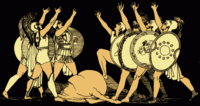Seven Against Thebes
| Seven against Thebes | |
 The Oath of the Seven Chiefs by Alfred Church |
|
| Written by | Aeschylus |
|---|---|
| Chorus | Theban Women |
| Characters | Eteocles Spy Antigone Ismene Herald |
| Setting | Citadel of Thebes |
The Seven against Thebes (Greek: Ἑπτά ἐπί Θήβας, Epta epi Thēbas) is a mythic narrative whose classic statement is found in the play by Aeschylus (467 BCE) concerning the battle between the Seven led by Polynices, traditional Theban enemies, and the army of Thebes headed by Eteocles and his supporters. The same story is told in Euripides' Phoenician Women (ca 409 BCE).
An early telling was contained in the lost Greek Thebaid, an epic poem that was regarded as forming part of a Theban Cycle, which discerning critics by the fifth century no longer attributed to Homer. Fragments of its text survive as quotations preserved by later authors.
Contents |
Plot summary
When Oedipus stepped down as King of Thebes, he gave the kingdom to his two sons, Eteocles and Polynices, who agreed to alternate the throne every year.[1] After the first year, Eteocles refused to step down and Polynices attacked Thebes with his supporters (the eponymous Seven). The drama has very little plot, as such. The bulk of the play consists of a scout describing each of the seven captains that lead the Argive army against Thebes, as well as the devices on their respective shields. Eteocles, in turn, announces which Theban commander he will send against each Argive attacker. When Polynices is revealed to be the last of the seven captains, Eteocles resolves to meet his brother in single combat, and exits. Following a choral ode, a messenger enters, announcing that Eteocles and Polynices have killed each other in battle. Their bodies are brought on stage, and the chorus mourns them; Antigone and Ismene then enter, and join in the mourning.
Due to the popularity of Sophocles's Antigone, the ending of Seven Against Thebes was rewritten about fifty years after Aeschylus's death.[2] Where the play (and the trilogy which it concluded) was meant to end with sombre mourning for the dead brothers, it instead contains the ending as follows: a messenger appears, announcing a prohibition against burying Polynices; Antigone, however, announces her intention to defy this edict.
The mythic content
The mytheme of the "outlandish" and "savage" Seven who threatened the city has traditionally seemed to be based on Bronze Age history in the generation before the Trojan War,[3] when in the Iliad's Catalogue of Ships only the remnant Hypothebai subsists on the ruins. Yet archaeologists have been hard put to locate seven gates in "seven-gated Thebes":[4]In 1891 Ulrich von Wilamowitz-Moellendorff declared that the seven gates existed only for symmetry with the seven assailants, whose very names vary: some have their own identity, like Amphiaraus the seer, "who had his sanctuary and his cult afterwards... Others appear as stock figures to fill out the list," Burkert remarks. "To call one of them Eteoklos, vis-à-vis Eteokles the brother of Polyneikes, appears to be the almost desperate invention of a faltering poet"[5] Burkert follows a suggestion made by Ernest Howald in 1939 that the Seven are pure myth led by Adrastos (the "inescapable") on his magic horse, seven demons of the Underworld; Burkert draws parallels in an Akkadian epic text, the story of Erra the plague god, and the Seven (Sibitti), called upon to destroy mankind, but who withdraw from Babylon at the last. The city is saved when the brothers simultaneously run each other through. Burkert adduces a ninth-century relief from Tell Halaf which would exactly illustrate a text from II Samuel 7: "But each seized his opponent by the forelock and thrust his sword into his side so that all fell together".

The Seven Against Thebes were
- Adrastus
- Amphiaraus
- Capaneus
- Hippomedon
- Parthenopeus
- Polynices
- Tydeus
Allies:
- Eteoclus and Mecisteus. Some sources, however, state that Eteoclus and Mecisteus were in fact two of the seven, and that Tydeus and Polynices were allies. This is because both Tydeus and Polynices were foreigners. However, Polynices was the cause of the entire conflict, and Tydeus performed acts of valour far surpassing Eteoclus and Mecisteus. Either way, all nine men were present (and killed) in the battle, save Adrastus.
The defenders of Thebes included
- Creon
- Megareus
- Poriclymenus
- Melanippus
- Polyphontes
- Hyperbius
- Actor
- Lasthenes
See also Epigoni, the mythic theme of the Second War of Thebes
Notes
- ↑ The alternation of "co-kings" survived into historic times at culturally conservative Sparta.
- ↑ Aeschylus. "Prometheus Bound, The Suppliants, Seven Against Thebes, The Persians." Philip Vellacott's Introduction, pp.7-19. Penguin Classics.
- ↑ "There is no reason to suppose that the tale was not based on historical fact" Cambridge Ancient History II (1978:168), noted by Burkert 1992:107n.
- ↑ Burkert 1993:107-08 briefly surveys the attempts, with bibliography.
- ↑ Burkert 1993:108.
References
- Burkert, Walter 1992. The Orientalizing Revolution: Near Eastern Influence on Greek Culture in the Early Archaic Age "Seven against Thebes" pp 106-14. Burkert draws parallels between Greek and Ancient Near Eastern materials. Notes and bibliography.
Translations
- A. S. Way, 1906 - verse
- E. D. A. Morshead, 1908 - verse: on-line text
- G. M. Cookson, 1922 - verse
- Herbert Weir Smyth, 1922 - prose: full text
- David Grene, 1956 - verse
- Philip Vellacott, 1961 - verse
- Will Power, 2001 - verse, lyric
| Plays by Aeschylus
The Persians | Seven Against Thebes | The Suppliants | Agamemnon | The Libation Bearers | The Eumenides | Prometheus Bound (spurious)
|
|---|